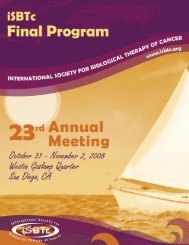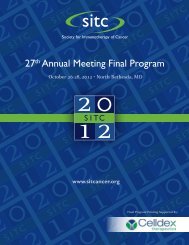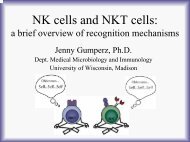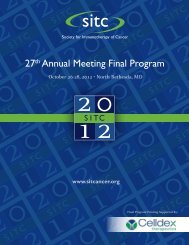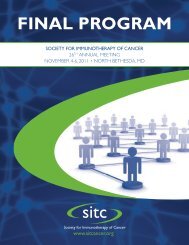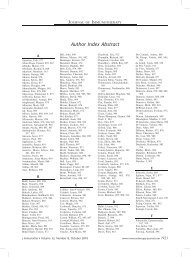Abstracts for the 25th Annual Scientific Meeting of the International ...
Abstracts for the 25th Annual Scientific Meeting of the International ...
Abstracts for the 25th Annual Scientific Meeting of the International ...
Create successful ePaper yourself
Turn your PDF publications into a flip-book with our unique Google optimized e-Paper software.
J Immuno<strong>the</strong>r Volume 33, Number 8, October 2010<br />
<strong>Abstracts</strong><br />
Our observations are consistent with <strong>the</strong> notion that Treg have an<br />
anti-inflammatory and protective role in CRC, however this role is<br />
compromised by <strong>the</strong>ir interaction with MC in <strong>the</strong> course <strong>of</strong><br />
progressive disease. Thus, <strong>the</strong> cross talk between MC and Treg<br />
determines <strong>the</strong> level <strong>of</strong> inflammation in CRC. The shift <strong>of</strong> Treg to a<br />
pro-inflammatory phenotype is a turning point in <strong>the</strong> escalation <strong>of</strong><br />
cancer-associated inflammation 1,2 (see commentary 3 ).Basedon<strong>the</strong>se<br />
observations we propose that MC and <strong>the</strong>ir interaction with Treg are<br />
suitable targets <strong>for</strong> effective <strong>the</strong>rapeutic intervention in CRC.<br />
References:<br />
1. Blatner NR, Bonertz A, Beckhove P, et al. In colorectal cancer<br />
mast cells contribute to systemic regulatory T-cell dysfunction.<br />
Proc Natl Acad Sci USA. 2010.<br />
2. Gounaris E, Blatner NR, Dennis K, et al. T-regulatory cells shift<br />
from a protective anti-inflammatory to a cancer-promoting proinflammatory<br />
phenotype in polyposis. Cancer Res. 2009;69:5490–5497.<br />
3. Colombo MP, Piconese S. Polyps wrap mast cells and treg<br />
within tumorigenic tentacles. Cancer Res. 2009.<br />
Roles <strong>of</strong> Interleukin-4 Receptor a-chain on Glioma-Infiltrating<br />
Monocytes<br />
Gary Kohanbash*, Arlan H. Mintz*, Kayla McKaveney*, Hea<strong>the</strong>r<br />
A. McDonald*, John R. Ohlfestw, Hideho Okada*, Mitsugu<br />
Fujita*. *University <strong>of</strong> Pittsburgh, Pittsburgh, PA; w University <strong>of</strong><br />
Minnesota, Minneapolis, MN.<br />
Several epidemiological studies have indicated association <strong>of</strong> single<br />
nucleotide polymorphisms and haplotypes in <strong>the</strong> IL-4Ra gene with<br />
altered glioma risk and prognosis. IL-4Ra is expressed on<br />
immunosuppressive cells <strong>of</strong> monocyte lineage and mediates <strong>the</strong>ir<br />
production <strong>of</strong> trans<strong>for</strong>ming growth factor (TGF)-b in response to IL-<br />
4 or IL-13. In this regard, our evaluation <strong>of</strong> tumor-infiltrating<br />
leukocytes in human malignant gliomas (n = 7) revealed that gliomainfiltrating<br />
CD14 + monocytes express high levels <strong>of</strong> IL-4Ra. By<br />
contrast, CD14 + monocytes in peripheral blood expressed barely<br />
detectable levels <strong>of</strong> IL-4Ra, suggesting <strong>the</strong> unique up-regulation <strong>of</strong><br />
IL-4Ra in <strong>the</strong> glioma microenvironment. Based on <strong>the</strong>se observations,<br />
we sought to address <strong>the</strong> functional significance <strong>of</strong> IL-4Ra in a<br />
recently developed murine de novo glioma model. We induced de<br />
novo gliomas in BALB/c-background mice by intracerebroventricular<br />
transfection <strong>of</strong> oncogenes using <strong>the</strong> Sleeping Beauty transposon<br />
system. IL-4Ra-deficient (Il4ra / ) mice exhibited significantly<br />
prolonged symptom-free survival compared with WT mice; median<br />
survival was 89 and 55.5 days, respectively. Consistently, gliomas<br />
induced in <strong>the</strong> WT mice were infiltrated with significantly higher<br />
numbers <strong>of</strong> CD11b + Gr1+ immunosuppressive monocytes than<br />
those in <strong>the</strong> Il4ra / mice. We subsequently isolated gliomainfiltrating<br />
CD11b + Gr1+ monocytes to address <strong>the</strong>ir functions. RT-<br />
PCR and ELISA revealed that <strong>the</strong> monocytes derived from WT mice<br />
express significantly higher levels <strong>of</strong> TGF-b. SinceTGF-b is known<br />
to inhibit <strong>the</strong> function <strong>of</strong> effector T cells, we addressed <strong>the</strong><br />
significance <strong>of</strong> T cells in glioma development by inducing gliomas<br />
in Rag1-deficient (Rag1 / ) mice, which lack adaptive immune<br />
cells including T cells. Rag1 / mice exhibited significantly<br />
shortened survival compared with WT mice. Taken toge<strong>the</strong>r, <strong>the</strong>se<br />
data suggest that IL-4Ra expression on glioma-infiltrating monocytes<br />
may promote <strong>the</strong> immunosuppressive microenvironment <strong>of</strong> gliomas<br />
through a variety <strong>of</strong> mechanisms including TGF-b production and T<br />
cell inhibition, <strong>the</strong>reby facilitating glioma growth.<br />
Myeloid-derived Suppressor Cells and Decreased Interferon<br />
Responsiveness in Tumor-Bearing Mice<br />
Bethany L. Mundy*, Gregory Lesinskiw, Kristen Benningerz,<br />
Mahmood Khanz, Periannan Kuppusamyz, Kristan Guenterbergw,<br />
Sri Vidya Kondadasulaz, Abhik Ray Chaudhuryz, Melanie Kreinerz,<br />
Gregory Youngz, DenisGuttridgez, William E. Carsony. *Integrated<br />
Biomedical Sciences; w Internal Medicine; ySurgery, The Ohio State<br />
University; zThe Ohio State University, Columbus, OH.<br />
Our group and o<strong>the</strong>rs have determined that immune effector cells<br />
from patients with advanced cancers exhibit reduced activation <strong>of</strong><br />
IFN induced signaling pathways although <strong>the</strong> mechanisms underlying<br />
this observation have not been delineated. We hypo<strong>the</strong>sized<br />
that increases in myeloid-derived suppressor cells (MDSC), which<br />
are known to be elevated in <strong>the</strong> setting <strong>of</strong> advanced cancers, could<br />
interfere with <strong>the</strong> host immune response to tumors by inhibiting<br />
immune cell responsiveness to interferons. The C26 murine<br />
adenocarcinoma model was employed to study immune function<br />
in advanced malignancy. This model can mimic advanced disease<br />
in humans by <strong>the</strong> development <strong>of</strong> cancer cachexia which is<br />
associated with weight loss, aggressive tumor growth, and elevated<br />
levels <strong>of</strong> IL-6. Splenocytes from tumor-bearing mice exhibited<br />
reduced phosphorylation <strong>of</strong> STAT1 (P-STAT1) on Tyr 701<br />
(P



